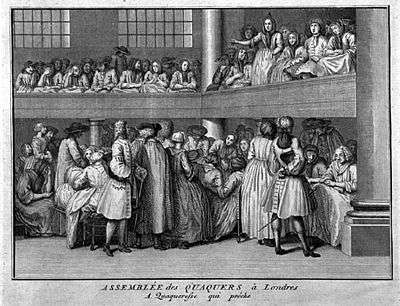Quaker views on women

Quaker views on women have always been considered progressive in their own time (beginning in the 17th century), and in the late 19th century this tendency bore fruit in the prominence of Quaker women in the American women's rights movement.
The early history of attitudes towards gender in the Religious Society of Friends (aka Quakers) is particularly notable for providing for one of the largest and most equitable roles for women in the Christian tradition at the time, despite not endorsing universal equality until much later.
For many outside observers during the first hundred years of Quakerism, the most surprising aspect of Quakerism was that "ministry" – the prerogative to speak during a Quaker meeting – was open to women from the very beginnings of the movement in the 1650s. One of the earliest to formulate direct biblical justification for this was Sarah Blackborow.[1] In James Boswell's Life of Johnson, Samuel Johnson's opinion of a female Quaker preacher was recorded thus: "Sir, a woman's preaching is like a dog walking on his hind legs. It is not done well; but you are surprised to find it done at all." Especially in the early years, a large number – even possibly the majority – of traveling Quaker preachers were women.[2] Aside from ministry, Quaker women were allowed to travel alone and to publish, which was also unusual for the time.[3]
For many Quakers, both historical and contemporary, the inclusion of women is part of what is now called the "Testimony of Equality". However, despite that testimony, women's roles were not completely equal for many years. In the beginning, Meetings for Business were dominated by male Friends, but within twenty-five years, George Fox ordered establishment of separate women's meetings when he faced challenges to his leadership. Particularly controversial was his decision that women's meetings for discipline should be the first to pass on a couple's intention to be married. Separate meetings declined by the 19th century and were eliminated later. Having authority over any business at all – let alone authority over men (in the form of approving or denying marriages) – was a radical move in the 17th century, and gave women then-rare experience in running organizations.[4] Concerning the introduction and much later dissolution of separate meetings, one historian writes,
- "On balance, and in the long run, I believe that the separate women's meeting was good for women; indeed, it may be said to have been a cradle not only of modern feminism but of the movements of abolitionism, women's suffrage, and peace activism, all of which were, and are, enlivened by the presence (even predominance) of Quaker female leaders."[5]
Quakers were heavily involved in the 19th-century movement for women's rights in America; the landmark 1848 Seneca Falls Declaration was in large part the work of Quaker women, and has numerous Quaker signatories, well out of proportion to the number of Quakers in American society at large.[6]. The tradition of Quaker involvement in women's rights continued into the 20th and 21st centuries, with Quakers playing large roles in organizations continuing to work on women's rights.
See also
- Daughters of Light: Quaker Women Preaching and Prophesying.
References
- ↑ E. g. in A Visit to the Spirit in Prison... (London, 1658).
- ↑ The Role a Female Traveling Minister Played in Spreading Quaker Beliefs by Colleen Clark
- ↑ One of several prolific pamphleteers was Dorothy White. Retrieved 20 March 2012.
- ↑ QUAKER VIEWS - That of God in Everyone
- ↑ Mack, Phyllis, Visionary Women: Ecstatic Prophecy in Seventeenth-Century England. Berkeley: University of California Press, 1991. Mack's views are given a qualified endorsement by another historian, Anne Hughes, in The Emergence of Quaker Writing (Routledge 1996), saying historians should be skeptical of such "spectacular claims" but there is "more validity in this claim than in most." (page 146)
- ↑ Article from National Portrait Gallery Archived July 9, 2011, at the Wayback Machine.
Further reading
“Women in the Society of Friends”, by Janet Scott in A Quaker miscellany for Edward H. Milligan, edited by David Blamires, Jeremy Greenwood and Alex Kerr, published by David Blamires (1985) ISBN 0-9510152-1-4